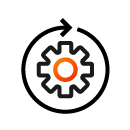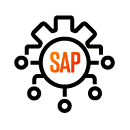Introduction to SAP S/4HANA
SAP S/4HANA is an innovative approach to the end‑to‑end management of all business processes. It comprises the SAP S/4 application and the SAP HANA database, which uses in‑memory database processing technology to significantly improve the speed of data use and analysis.
The purpose of implementing an ERP system is to reduce the cost of running a business, enhance the efficiency of its processes, improve quality control, increase sales, and reduce production time. In short – a properly prepared ERP system is the foundation on which you can build your competitive advantage.
Strengths of SAP S/4HANA compared to other popular ERP systems
There are many ERP systems on the market, each with its unique features, and choosing the best one depends on the exact needs of the organization. Compared to other solutions, SAP S/4HANA stands out due to its:
- in-memory database (SAP HANA);
- intuitive and responsive user interface (SAP GUI has been replaced by SAP Fiori);
- integration with advanced technologies;
- real-time data analysis;
- simplified data structure;
- specific, ready-made business processes, arranged based on the experience of experts from many industries.
What exactly is SAP S/4HANA and how important is it for organizations?
The role of an ERP system is first and foremost to ensure reliability, conduct real-time analytics, and provide the ability to continuously evolve. With SAP S/4HANA companies can not only catch up with their competitors but also gain a technological edge and make decisions with an eye to the future.
SAP S/4HANA is a cloud ERP system for enterprise resource planning that consists of various tools and extensions, not all of which are mandatory to implement. Hicron’s experts help clients select features that will improve the efficiency of their enterprise and accelerate their business processes. Most of the mentioned functionalities are related to the area of logistics and finance; they include, for example, the Universal Journal, which:
- allows accounting and financial documents to be stored in one place;
- facilitates access to key performance indicators (KPIs);
- supports informed decision-making based on up-to-date data thanks to its customized cockpits;
- improves reporting.
What is the biggest change brought by SAP S/4HANA?
The most popular version to date, SAP ECC 6.0, still used technologies that were developed in the 1990s. The latest generation of SAP S/4HANA is based on an advanced in-memory platform and addresses today’s business needs.













